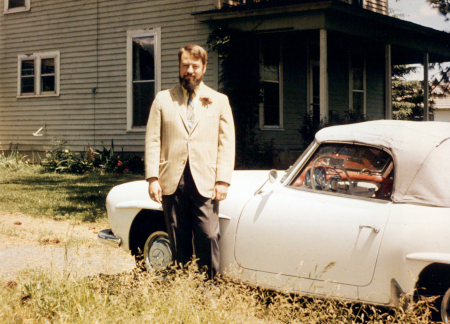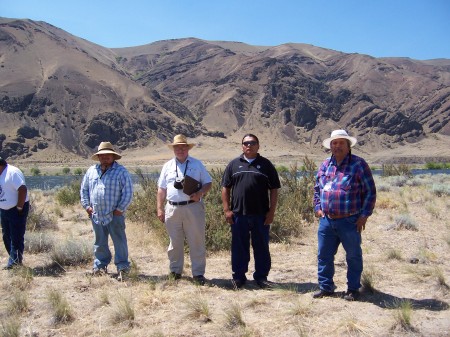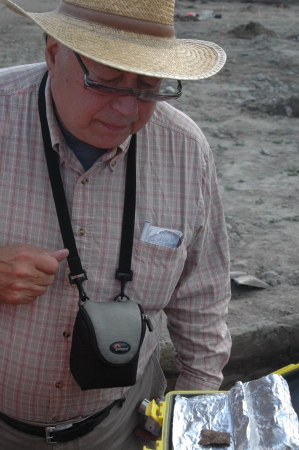David Rice:
CLASS OF 1961
Garfield High SchoolClass of 1961
Seattle, WA
David's Story
After high school, I pursued my academic interest in archaeology and American Indians at University of Washington. Along the way, I continued my participation in university sponsored archaeological digs in the NW. I went to graduate school at WSU in Pullman to continue my archaeological training. There I became involved with NW Indian tribes, particularly Nez Perce, Yakama, Wanapum, Colville, and Chehalis. Garfield HS Science Instructor John Putnam became interested in NW archaeology and Indian art, and joined me in archaeological studies of Indian rock images in the lower Snake River region of Washington.
In 1967 I initiated pioneering archaeological survey work at the Hanford Site nuclear reservation, continuing intermittent project work there until 1988. Later, in the 1990s, I participated in the National Park Service Wild & Scenic River Study evaluation of the Hanford Reach of the Columbia River. I was surprised when I read President Clinton's Proclamation establishing Hanford Reach National Monument, to find excerpts from my writings as part of his proclamation! An unexpected opportunity to put words in the mouth of President of the United States!
When I completed my PhD degree I became an anthropology professor at the University of Idaho, Moscow, ID. Initially, besides teaching, I became involved in interdisciplinary studies and practical Community Development for small Idaho communities. In the McGovern era of political reform (1972) I was elected as a Delegate to the Democratic State Convention, serving on the Human Rights Sub-committee of the Platform Committee. In 1974 I assisted the National Park Service (Washington, DC) in plans for implementing provisions of a Federal law (P.L.93-291, Moss-Bennett Bill) which authorized the Government to fund archaeological investigations. The rest of my professional career was spent in working with Federal agencies in meeting their obligations under the law.
The cart was before the horse! After 6 years of nationwide explosion in archaeological excavations, public issues began to emerge: Whose heritage was being studied? What happens to recovered Indian skeletal remains? Impacts to Sacred Sites of living indigenous peoples? New Federal laws tempered the unbridled archaeological frenzy, and brought Indian Tribes into the business of Federal archaeology since 1991.
In 1980 I was elected to serve as Chair of the Association for the Humanities in Idaho [now Idaho Humanities Council], funded by the National Endowment for the Humanities. I brought retired Garfield HS English Instructor Claude Wilson to assist in the evaluation of the Idaho program. Also, I helped to start an Oral History Program to preserve local communities and minority heritage there.
I moved back to Seattle in 1981 and was hired by the US Army Corps of Engineers as an archaeologist. At first, my work centered on civil projects at dam reservoirs in Montana and Idaho, but soon also supported military projects for Army and Air Force in various parts of the West.
In August 1982, while serving as a volunteer for Salmon National Forest, I survived a small airplane crash in the central Idaho wilderness, River of No Return.
For the Washington State Centennial, the Governor requested the Corps of Engineers to organize a session on "Rescue Archaeology in Pacific Development" at the international Circum-Pacific Archaeology Conference at Seattle Center; I organized and moderated the session in August 1989, attended by key archaeologists from Russia, People's Republic of China, Australia, Canada, Mexico, Japan, and a representative of the World Bank.
In 1994 the Assistant Secretary of the Army (Civil Works) requested assistance to set up an information workshop with Indian tribes, so since I already knew what needed to be done, I took the lead for a plan at meetings held at Fort Belvoir, VA. I was appointed as a member to the Army Corps of Engineers Headquarters Native American Inter-governmental Task Force, and worked on plans for 12 Indian workshops across the US. In the NW, my District in Seattle was asked to host an Indian workshop and conduct a needs assessment for Indian communities here. This was done between 1995-97. At this time I was designated by my commander to serve henceforth in a dual capacity as District Archaeologist and Native American Coordinator.
In the Corps, I worked on many anthropological projects with tribes, such as Kootenai Indian Place Names on the Kootenai River; Traditional Uses and Sacred Sites of the Blackfeet; recovery and reburial of Indian graves with Yakama, Wanapum, Nez Perce, Umatilla, Suquamish, and Lower Elwha Klallam tribes. Emergency shoreline protection at Lummi, Quilleute, and Shoalwater Bay reservations were also accomplished with my coordination. I also arranged meetings for visits by the Assistant Secretary of the Army (CW) for meetings with tribes in the NW. In addition, I became involved in issues of habitat protection and restoration for fish & wildlife, protection for traditionally used native plants, and worked with EPA at Superfund sites at Eagle Harbor, Manchester, Bellingham Bay in Washington, and Kellogg-Wallace mining area in Idaho. In 1995-99 I brought together field crews at Yakima Training Center that included Wanapum and Yakama Indian members on archaeological crews f...Expand for more
rom universities, to bring together both perspectives and build mutual respect. I retired from the Corps of Engineers in 2006, receiving The Commander's Award for Civilian Service.
Since my retirement, I have been restoring my body and soul from the bureaucratic battles fought while in the Federal service. Now I have been renewing my ties with the Indian tribes that I formerly met and worked with during my career, enjoying more fully their ceremonies and social acceptance as an elder. As an archaeologist, I have found redemption as a champion for giving voice to the Tribes, and this time, they know how to use it!
Highlights of adventure travel and personal achievements in my life include:
* Lunch and 'tall tales' with colleagues at the Smithsonian "Castle," Washington, D.C.
* Walking the Inca Trail into Machu Picchu archaeological site in Peru
* Discovery of fossil mammoth remains at American Falls reservoir, ID,at Lewiston, ID, and in the
Horse Heaven Hills, eastern Washington
* My Brotherhood ceremony in Boy Scouts in the Wasatch Mountains of Utah
* Best Chinese food ("Chifa") that I ever experienced: Chinatown, Lima, Peru
* Found my first Indian chipped stone arrowhead: James River, VA, in 1947
* Exploring the world of birds (300 species) at Manu Biosphere, and getting there on Madre de Dios River, Peru
* Looking close-up into the eyes of Luna (L Pod -95), the orca, at Nootka Sound, British Columbia, Canada
* Hitting the target at 30' with a Yagua Indian blowgun in the Amazon rainforest of Peru
* Traveling 8,000 miles in one month by Volvo on the Alaska-Canada and Cassiar
highways, Canada & Alaska
* Visiting the gold ransom room where the Inca King Atahualpa was held prisoner in 1532 by the
Spanish, Cajamarca, Peru
* Being at the top of the Empire State Building, New York, in 1947
* Discovering and recording 100s of archaeological sites on the Hanford Reach Columbia River, the Snake River region, and the Kootenai River, and working with Tribal elders in identifying sacred sites associated with them, Washington, Idaho, and Montana
* Finding a Jewish deli in La Paz, Bolivia
* Experiencing sand and seafood at Cozumel, Akumal, Puerto Vallarta, Puerto Escondido, and Baja, Mexico;
Chiclayo and Trujillo, Peru
* Being 5,200' deep in a Texas molybdenum mine
* Viewing the gold and silver treasures from the tomb of the Lord of Sipan, Chiclayo Museum, Peru
* Visiting Cochise's Chiricahua Apache stronghold in the Dragoon Mtns., Arizona
* Exploring the caves of Loltun in Yucatan, Mexico
* Riding an elephant at the St. Louis Zoo, Missouri
* Speaking at the Tribal reburial ceremony for the ancestral remains recovered by WSU archaeologists from the Marmes Rockshelter in the 1960s, Palouse River, Washington
* Attending a "Days of the Dead" Mexican family observance at Oaxaca, Mexico
* Visiting the oldest complex of ceremonial architectural structures in the New World (3200-3500 BC), Caral, Peru
* Conducting whitewater raft archaeological surveys, Salmon River, Idaho
* Witness to the launch of a Patriot missile into space & return at Army's White Sands Missile Range, New Mexico
* Visiting Maya villages around San Cristobal de las Casas defended by Sub-Comandante Marcos, Chiapas, Mexico
* Wandering through the Indian markets at Chichicastenango and Solola, Guatemala
* Spending a star-lit night on Island of the Sun (Inca religious site) in Lake Titicaca on the altiplano at 12,000' in Bolivia
* Climbing the underground tunnels inside Temple of the Warriors, Chichen Itza and
Temple of the Wizard, Uxmal, Mexico
* Falling through the floor of a flimsy public toilet in the Amazon rainforest, into the dark abyss of a deep earthen hole, and catching a secure cross timber to break the fall and pull myself out! Boca Manu, Peru
* Being "King of Hearts," leading a renaissance fair community parade at Moscow, Idaho, the day that Mount St. Helens volcano erupted, dropping volcanic ash across the inland NW.
* Presenting my first professional paper at the Society for American Archaeology meetings in Mexico's National Museum of archaeology in Mexico, D.F.
* Flying the Nazca Line geo-glyphs in the Atacama Desert, Peru
* Securing the participation of Columbia Basin Indian tribes in the Government's interagency study and EIS for Operation of the Federal Columbia River Power System
* Attaining an on-land elevation of 20,013' (6100m) in the central Peruvian Andes Mountains on the road to Cusco
* Viewing the Rosetta Stone first-hand in the British Museum, London, UK
* Standing at the WSDOT graving dock construction site at Port Angeles, WA, in the midst of the Tse-Whit-zen Village archaeological and grave sites, with Lower Elwha Klallam tribal officials and determining what to do!
* Attending a formal reception at Blair House (across from The White House) for Assistant Secretary of the Interior during the National Meeting of Association of State Historic Preservation Officers, Washington, D.C.
* Watching the condors fly, Colca Canyon, Peru
* Standing in the inner circle of the Stonehenge, Salisbury Plain, UK
* Standing at the top of Temple of the Sun, Teotihuacan, Mexico
* Standing in the tomb of Lord Pacal in the Temple of The Inscriptions, Palenque, Mexico
You might surmise that I spent much of my life out standing in a field! So get busy and walk!
Register for Free to view all details!
Yearbooks
Register for Free to view all yearbooks!
Reunions
Register for Free to view all events!
Photos








